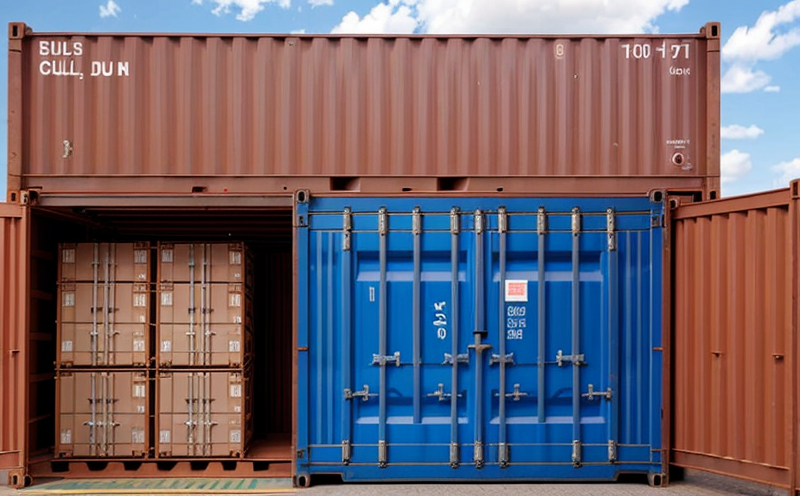USP Compression Resistance Testing of Packaging
In pharmaceutical manufacturing, ensuring that packaging materials meet stringent quality and safety standards is paramount. The United States Pharmacopeia (USP) sets forth comprehensive guidelines for the testing of various aspects related to drug products, including their containers and closures. One critical test within this framework is the USP Compression Resistance Test for Packaging. This test assesses how well a container can withstand external forces without compromising its integrity or compromising the quality of the product inside.
During compression resistance testing, specimens are subjected to increasing pressure until they deform or fail under load. The goal is not only to ensure physical strength but also to prevent any potential leakage or contamination that could affect drug efficacy and patient safety. This test plays a crucial role in validating whether packaging complies with USP requirements for maintaining the stability and quality of pharmaceutical products.
The testing procedure involves selecting appropriate specimens representative of the actual container closures used during production processes. Specimens are then placed into a compression tester, where they undergo progressively higher levels of applied force until failure occurs. The amount of force needed to cause deformation or breakage indicates the material’s resilience and durability.
For accurate results, proper specimen preparation is essential before conducting this test. Materials must be free from defects such as cracks or other imperfections that could influence the outcome. Additionally, standardization ensures consistency across different batches of samples being tested, ensuring reliable comparisons between them.
The apparatus used in these tests includes compression testers designed specifically for pharmaceutical applications. These machines provide precise control over applied pressures while monitoring deformation rates accurately. Compliance with relevant international standards such as USP, ISO, and ASTM guarantees that the equipment meets industry benchmarks.
Acceptance criteria define what constitutes acceptable performance based on specified limits set by regulatory bodies like FDA or EMA. For instance, if a particular type of container closure must not allow more than 0.1% leakage under certain conditions, then any specimen failing to meet this threshold would be deemed non-compliant.
- Environmental and Sustainability Contributions: By ensuring robust packaging integrity through rigorous testing methods like compression resistance, pharmaceutical companies contribute positively towards reducing waste associated with improperly sealed containers. Such measures help minimize environmental impact by preventing unnecessary disposal of potentially harmful substances into landfills or water bodies.
- Competitive Advantage and Market Impact: Companies that invest in advanced packaging technologies and adhere strictly to regulatory guidelines stand out among competitors. They gain a competitive edge by delivering products packaged safely, securely, and efficiently, thereby enhancing customer satisfaction and loyalty.
Why It Matters
The importance of USP Compression Resistance Testing cannot be overstated in the realm of pharmaceutical manufacturing. Properly sealed containers protect drugs from external factors such as temperature fluctuations, humidity changes, light exposure, and physical damage during transportation or storage. Ensuring that packaging meets these stringent requirements helps maintain product quality throughout its lifecycle.
Non-compliance with USP standards could lead to compromised drug stability, increased risk of contamination, and ultimately, recalls or withdrawals from the market. These consequences not only result in financial losses but also damage brand reputation and consumer trust.
Pharmaceutical companies must adhere strictly to regulatory guidelines because they have a direct responsibility towards public health and safety. Failure to do so can lead to severe penalties imposed by regulatory authorities, including fines, suspension of manufacturing operations, or even criminal charges in extreme cases.
Environmental and Sustainability Contributions
Incorporating robust packaging into drug delivery systems helps reduce waste generation significantly. Properly sealed containers prevent premature degradation due to environmental conditions, thereby extending product shelf life without requiring excessive amounts of additional materials for re-sealing or replacement.
This approach promotes sustainable practices by minimizing landfill contributions from discarded packaging items that fail to meet necessary performance standards. Additionally, using eco-friendly materials in the manufacturing process further enhances sustainability efforts.
Competitive Advantage and Market Impact
Investing in high-quality packaging solutions gives companies a significant competitive advantage in today’s highly regulated pharmaceutical industry. Compliance with USP standards demonstrates commitment to excellence, fostering trust among healthcare providers and consumers alike.
By prioritizing product safety above all else, firms can build strong brand loyalty while maintaining regulatory compliance. This strategic focus ensures long-term profitability through enhanced market share gains and reduced operational risks associated with non-compliance issues.





